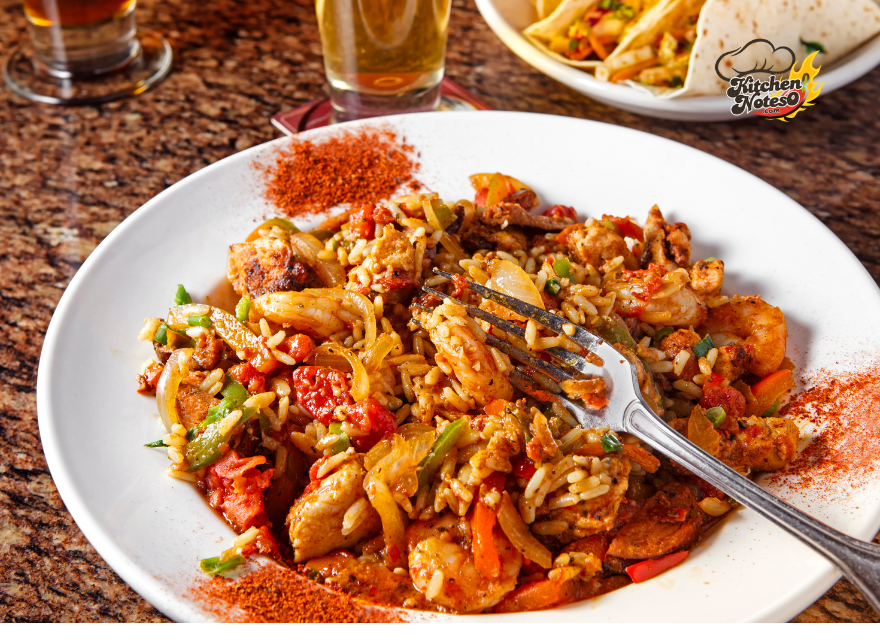Table of Contents

Introduction:
Jambalaya is a savory rice dish that developed in the U.S. state of Louisiana,
fusing African, Spanish, and French influences, consisting mainly of meat
and/or seafood, and vegetables mixed with rice and spices. West Africans and
Spanish people each had versions of jambalaya in their respective countries.
Historian Ibraham Seck states that Senegalese people were making
jambalaya.
The French introduced the tomato to West Africans, and they
incorporated the crop into their one-pot rice dishes, which created jambalaya
and enhanced jollof rice. Spanish people made paella, which is also a one-pot
rice dish cooked with meat and vegetables. These styles of cuisines blended
in Louisiana and resulted in cultural and regional variations of the dish.

History:
The history of Jambalaya points to a West African influence. Rice was and is aa
traditional staple in West Africa, where one-pot mixed rice dishes such as
thiéboudienne, benachin, or Jollof rice were common.In the records of the slave
Narratives, formerly enslaved African Americans from Louisiana, made
Jambalaya as a meal with rice, pork or chicken, red pepper, onion, lard, salt,
and pepper.
Black Americans adapted West African dishes in the Southern
United States by using North American ingredients. These meals were
prepared to survive during the era of slavery.
Some folklore claims that jambalaya originates from the French Quarter of New Orleans.
Orleans, in the original sector.
Some culinary scholars argue that it may
have been a local version of the Spanish rice dish paella. French influence
was strong in New Orleans, and native spices from Louisiana, the Gulf Coast, and the Caribbean may have changed this pilaf or paella into a unique New
World dish. As author and professor Judith Carney explains: “…jambalaya
resulted from cooking raw rice in the broth of stew composed of ingredients
from many cultural heritages.”

Ingredients :
● 2 tablespoons peanut oil, divided
● 1 tablespoon Cajun seasoning
● 10 ounces andouille sausage, sliced into rounds
● 1 pound boneless skinless chicken breasts, cut into 1-inch pieces
● 1 onion, diced
● 1 small green bell pepper, diced
● 2 ribs of celery, diced
● 3 cloves garlic, minced
● 1 (16-ounce) can crushed Italian tomatoes
● 1⁄2 teaspoon red pepper flakes
● 1⁄2 teaspoon ground black pepper
● 1 teaspoon salt
● 1⁄2 teaspoon hot pepper sauce
● 2 teaspoons Worcestershire sauce
● 1 teaspoon file powder
● 1 1⁄4 cups uncooked white rice
● 2 1⁄2 cups chicken broth

Directions :
Step 1:
Gather all ingredients.
Step 2:
Heat 1 tablespoon of peanut oil in a large heavy Dutch oven over medium
heat. Season sausage and chicken pieces with Cajun seasoning. Sautéthe
sausage until browned. Remove with a slotted spoon and set aside.
Step 3:
Add 1 tablespoon peanut oil, and sauté chicken pieces until lightly browned on
all sides. Remove with a slotted spoon and set aside.
Step 4:
In the same pot, sauté onion, bell pepper, celery, and garlic until tender.
Step 5:
Stir in crushed tomatoes, and season with red pepper, black pepper, salt, and hot
pepper sauce, Worcestershire sauce, and filé powder.
Step 6:
Stir in chicken and sausage. Cook for 10 minutes, stirring occasionally.
Stir in the rice and chicken broth.
Step 7:
Bring to a boil, reduce heat, and simmer for 20 to 25 minutes, or until the liquid is
absorbed.
Serving:
Jambalaya, with its hearty and satisfying ingredients, is a meal in itself. You
Don’t need to serve it with anything.
Storage:
● Cool leftovers completely. Store in the fridge in an airtight
container—lasts up to 4 days.
● Reheat gently on the stove or microwave with a splash of broth if
needed.

Conclusion:
Jambalaya ain’t just a recipe it’s a whole vibe. It brings folks together, gets
mouths watering, and always leaves a little heat behind. Try it once. You’ll be
making it again. Probably soon.
It’s great to share. Make it your own and enjoy this!
Also, I wrote an article about Reuben Sandwich. In learn this article, you will learn how to cook homemade Reuben Sandwich.